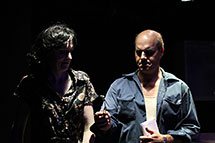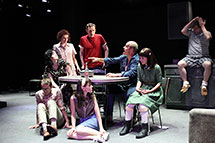
Down There
Written & Directed by Randy Sharp
September 9 - October 30, 2010Thursdays-Saturdays at 8:00PM
Previews $18 Adults; $15 Seniors/Students | Regular $20 Adults; $17 Seniors/Students
During 3 months in 1965, a 16 year-old girl was tortured and killed in the Indiana home of the Menckl family. Down There explores how this could have happened and what it might have felt like to the perpetrators as well as the victim.
Casey Kindens and her sister Joyce were boarded at Pat Menckl's house while their parents went to find work. Mr. and Mrs. Kindens knew nothing of the Menckls, and the sole connection was that Casey had played in the park with Pat's niece Paula once or twice. After a few weeks, when the $20-per-month boarding fee failed to arrive, Casey and Joyce were denied meals and beaten with a board. In an attempt to protect her polio-afflicted sister from further beatings, Casey took all the blame for future offenses, both real and imagined. The abuse escalated to the point where Casey was receiving daily life-threatening beatings, cigarette burns and scalding baths. Neighborhood teenagers joined in the torture, which was overseen by the sickly, phenobarbitol-addicted Pat.
After the words "I am a prostitute and proud of it" were carved into Casey's stomach, Pat realized that if anyone saw the girl's condition they all would "get in trouble." Pat forced Casey to write a letter to her parents, explaining that she had caused her injuries by going with a "gang of boys in the middle of the night." Following a final attempt at escape, Casey was dragged back into the home and beaten to death.
At no time during any of these events did Casey's sister attempt to alert anyone nor did any visiting neighbor contact the police when they heard Casey screaming for her life. How could a diverse group of people of various ages—who went to school, interacted with others, had their own families, ate snacks and played—return daily to a basement and torture a girl to death? And: Why didn't Casey run away? What was in her personal condition that allowed her to understand her abuse as something normal?
Based on the real-life 1965 torture murder of Sylvia Likens, Down There is a new play from Axis Company, written and directed by Randy Sharp (based on an original script by Randy Sharp & Michael Gump).
Casey Kindens and her sister Joyce were boarded at Pat Menckl's house while their parents went to find work. Mr. and Mrs. Kindens knew nothing of the Menckls, and the sole connection was that Casey had played in the park with Pat's niece Paula once or twice. After a few weeks, when the $20-per-month boarding fee failed to arrive, Casey and Joyce were denied meals and beaten with a board. In an attempt to protect her polio-afflicted sister from further beatings, Casey took all the blame for future offenses, both real and imagined. The abuse escalated to the point where Casey was receiving daily life-threatening beatings, cigarette burns and scalding baths. Neighborhood teenagers joined in the torture, which was overseen by the sickly, phenobarbitol-addicted Pat.
After the words "I am a prostitute and proud of it" were carved into Casey's stomach, Pat realized that if anyone saw the girl's condition they all would "get in trouble." Pat forced Casey to write a letter to her parents, explaining that she had caused her injuries by going with a "gang of boys in the middle of the night." Following a final attempt at escape, Casey was dragged back into the home and beaten to death.
At no time during any of these events did Casey's sister attempt to alert anyone nor did any visiting neighbor contact the police when they heard Casey screaming for her life. How could a diverse group of people of various ages—who went to school, interacted with others, had their own families, ate snacks and played—return daily to a basement and torture a girl to death? And: Why didn't Casey run away? What was in her personal condition that allowed her to understand her abuse as something normal?
Based on the real-life 1965 torture murder of Sylvia Likens, Down There is a new play from Axis Company, written and directed by Randy Sharp (based on an original script by Randy Sharp & Michael Gump).
Featuring: Laurie Kilmartin, Jim Sterling, George Demas, Britt Genelin, David Crabb, Brian Barnhart, Regina Betancourt and Lynn Mancinelli
Written by Randy Sharp (based on an original script by Randy Sharp & Michael Gump)
director: Randy Sharp
assistant director: Marc Palmieri
stage manager: Edward Terhune
assistant stage manager: Marc Palmieri
light designer: David Zeffren
assistant light designer: Amy Harper
sound designer: Steve Fontaine
costume designer: Elisa Santiago
dramaturgy: Christopher Swift, Marc Palmieri
carpenters: Chad Yarborough, Carlo Adinolfi, Jackie McCarthey
scenic painter: Jackie McCarthey
prop master: Lynn Mancinelli
costume construction: Aughra Moon
costume assistant: Britt Genelin
wig & hair designer: Regina Betancourt
website & graphic designer: Ethan Crenson
publicity/pr: Blake Zidell & Assoc.
photographer: Dixie Sheridan
box office: Marlene Berner
AXIS COMPANY
Artistic Director: Randy Sharp
Producing Director: Brian Barnhart
Executive Producer: Jeffrey Resnick
Running Time approximately 80 min.
Special Thank You
Jill Rice; Brian Gaddis; Michael Birnbaum; WIBC Radio Indianapolis; ABC News
This production is made possible by a generous grant from the Peter Jay Sharp Foundation.
Special Thank You
Jill Rice; Brian Gaddis; Michael Birnbaum; WIBC Radio Indianapolis; ABC News
This production is made possible by a generous grant from the Peter Jay Sharp Foundation.
“I am in awe at the accomplishment of 'Down There': this is genuinely cathartic theatre that enlarges our understanding of the human condition in an important way. It is harrowing and disturbing... it's compassionate and horrified in its examination of what our species proves that it's capable of.”
—Martin Denton, NYTheatre.com
“...one of the most harrowing nights of theater I have ever experienced...this may be the company's best work yet”
—Downtown Express
“...chilling...they deliver fright better than any modern horror flick. ”
—F.A.M.E. NYC Magazine
“...grippingly sinister...”
—Backstage
WATCH the 1965 radio interview | WIBC Indianapolis









